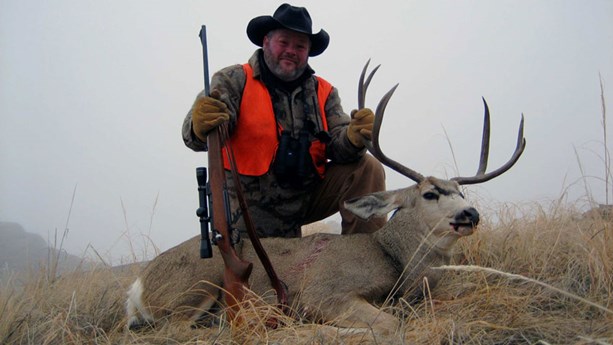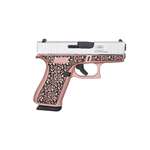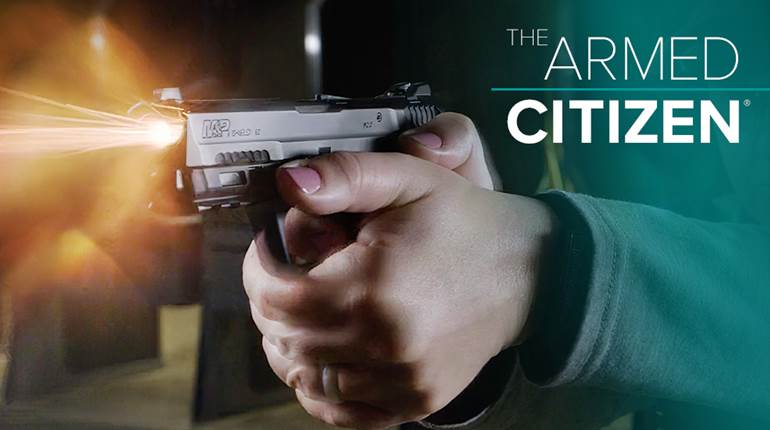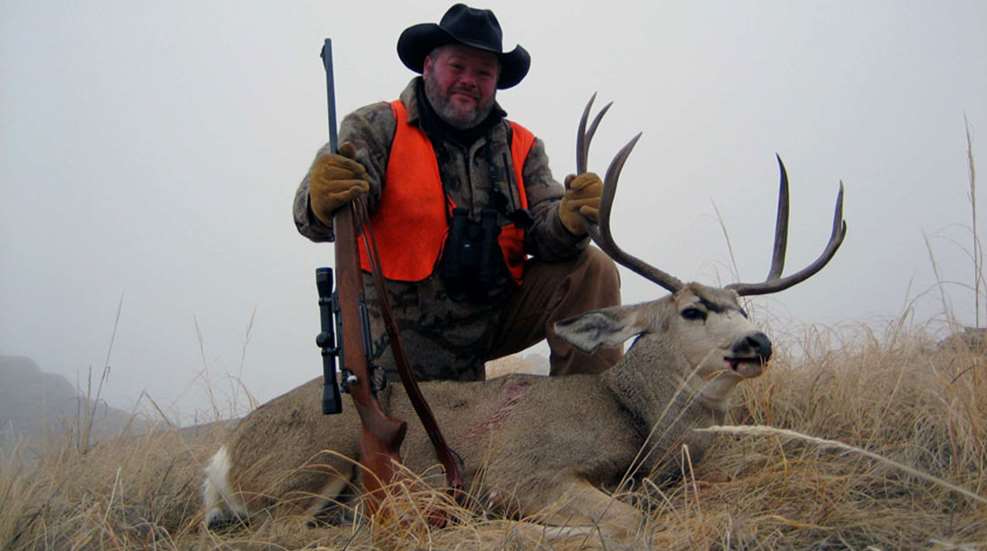
These two old friends were made 30 years apart, though they came into my life only about a decade apart. However, between the two of them I’ve taken countless deer, elk, pronghorn and wild pig, and the lessons I learned behind each rifle’s trigger stuck with me throughout my life. Here’s their story.
It was the mid-1970s when the gun, handloading and hunting bug bit me good. Before that I had consumed volumes of texts from the authors of the day—Cooper, Keith, Milek, Nonte, O’Connor and Skelton. As deep as my enthusiasm was, my wallet was proportionally shallow. I confess that I took a particular shine to the prose of Jack O’Connor. His adventures in Mexico, the Rockies, Alaska and Africa held a death grip on me.
O’Connor was known for his penchant toward the Winchester Model 70 Featherweight, especially in .270 Win. He held the .30-‘06 Sprg. in almost equal esteem and with sound reason. The .270 Win. is simply a .30-’06 Sprg. necked down to take a .277" bullet. O’Connor was also a foot and horseback hunter. Hunting mountainous or uneven desert terrain meant that he wanted the lightest rifle he could get. Heavy rifles can shoot great to be sure, but even out to 400 yards or a bit further, the bantam-weight rifles can certainly hold their own. One of his favorite animals to hunt was Coues deer, a tiny variant of whitetail that can be nervous, flighty and difficult to get a bullet into because of those characteristics.
He—like most gun and hunting writers—was an opinionated old cuss. His choice of rifle was the aforementioned Model 70 but not just any Model 70. He tried the post-’64 Model 70 and found it severely wanting in several ways. First and foremost was that slick bolt with an extractor he could barely see nestled into the face of it. As an old handloader from the days where you got the best recommendations you could and then set out on your own, he feared that the smaller bite the extractor had would tear off the rim of a hot handload leaving the hunter/shooter with a case stuck in the chamber. Right behind that confounded extractor was the spring-loaded, plunger-style ejector that, “…throws the damn cases over second base…” when shooting from the bench. The changes to the stock did not impress him either. In a nutshell, any hunter worth his salt would choose a pre-’64 Model 70 over what was offered at the time.
To rip off Shakespeare, “Ahh, but there’s the rub …” I was stuck in a dead-end job at the time, making maybe five bucks an hour. A brand new Model 70 was about $225, if I recall correctly. Even a beat up pre-’64 Model 70 fetched about $500, and if it was a factory Featherweight, add another $100 to $200 on top of that. And a pre-’64 Featherweight chambered in .270 Win.? Figure about a grand, depending on condition. There simply was no way for me to afford an O’Connor-approved rifle.
My stopgap measure was to get a new Model 70 chambered in .30-’06 Sprg. Beyond the tremendous savings, I chose the .30-’06 Sprg. for a couple of reasons; ammo for it was readily available anywhere, and it handled heavier bullets, making it a slightly better choice for larger animals like elk and moose—or so I thought.
There used to be a little block ad in the back of American Rifleman for years, advertising name-brand optics at discount prices. I wrote S.A. Wentling of Palmyra, Penn. and ordered my first Leupold M8 4x scope with center-pointed crosshairs. The price was $57, including postage. If I recall correctly, a Redfield Jr. mount and low rings cost less than $25.
I immediately began developing handloads for the new rifle. As I pursued my passion, I soon found out what many said was true; 110-gr. bullets do not go into tiny groups from a .30-’06 Sprg. with a 1:10 twist barrel. At 50 yards they can look great, but 100 yards scatters them like fine birdshot from an open-choke scattergun. The 180s, 190s and 200s were okay, but the 165-grs. seemed to be the most accurate and achieved a respectable velocity of 2,834 f.p.s. from the 22"barrel. By the way, I have tried that load, 57.0 grains of IMR 4350, behind any good 165-gr. bullet, in no less than six rifles chambered for .30-’06 Sprg., and every one grouped five shots into less than an inch—including a Remington 760 pump rifle.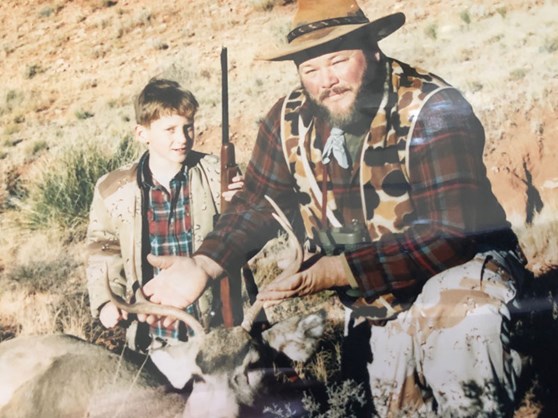
Off to Wyoming I went, confident of my rifle and myself. On a chilly September morning in 1982, I rode to near Daniel Junction with a friend in search of pronghorn. There was some patchy fog, but we got out and started walking toward a pair of decaying line shacks from a forgotten generation. Sure enough there was a little band of perhaps seven or eight does and fawns milling about near the old shacks. I dropped to one knee and with the rifle steadied in a tight sling I tracked the last doe in the line of strolling antelope. When she turned broadside I centered the reticle on her ribcage and squeezed the trigger. I recall the whole world in the field of view of the scope turned bright orange for an instant. The bullet made a sort of hollow thump, and the pronghorn dropped where she stood. Later that day around lunchtime, a small buck made the mistake of walking to within 350 yards of where we had parked the truck for our midday repast. This time I held the horizontal crosshair even with the top of the buck’s back. He, too, dropped at the shot.
A couple of weeks later, I was camped with some other buddies along the Little Greys River. I had spent the summer riding and finishing a three-year-old, green-broke gelding. The morning of a moonless night I saddled my horse, Buckshot, tied on the saddle scabbard and loaded the Model 70 into it. It was so dark, I could see absolutely nothing. My buddies told me not to worry; the horse has much better night vision than people. About 200 yards from camp, the trail made a hard left, and headed up the canyon. Right where the trail turned there had been a tree that had fallen, leaving a nice big hole full of pine needles. The reason I know about the hole is because Buckshot’s hind end fell into it, and he reared right on top of me planting the saddle horn in the center of my sternum. Were it not for the pine needles padding me, I might be dead from a broken sternum. More importantly, the Model 70 was still safely tucked into its scabbard. After pushing Buckshot off of me, I got up and back into the saddle. With my spurs tickling his ribcage constantly, he trotted about four miles to the top of the ridge. When I tied Buckshot to an aspen tree just below the ridge, he was grateful for the break.
I pulled the Model 70 from the scabbard and quietly chambered a round. My buddy, Brandt Clark, and I eased up to the rim overlooking a bowl on the other side just as there was enough light to shoot. Just as we peered over the top, a six-by-six bull elk shot out below us some 30 yards away. Brandt swung his .30-‘06 up, shot, and the bull slid on his nose. In the bottom of the bowl, perhaps 80 or 90 yards away, there were eight cows munching grass with another bull—likely the herd bull—on the far side. When Brandt shot this bull reared up on his hind legs and started turning right. I brought the rifle to my shoulder and shot just as the crosshairs hit fur. The bull ran about 30 yards before dropping.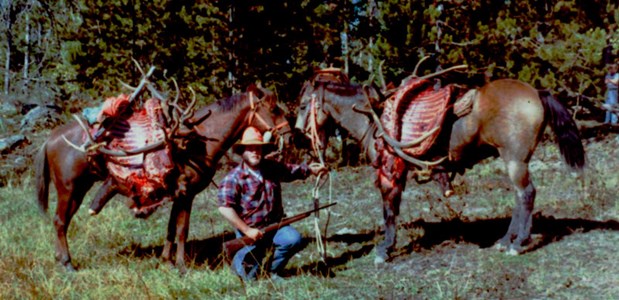
Three shots, three kills. I began to think I had a death ray in my hands. As opportunities presented themselves, I’d unlimber the Model 70 and kill deer, elk, pronghorn and feral pigs. I even entered a centerfire match for sporting rifles at a range near Arcata, Calif. one Saturday and won that division with it.
Early on, I decided to try the stockmaking trade and restocked the rifle with a blank from E.C. Bishop and Sons. It must have been a pretty old blank of black—and I mean black—Missouri walnut. The wood cut clean and gobbled the edge of cutting tools like ice cream. I learned a lot about how to sharpen chisels and gouges, as well as stockmaking in general from that project. Even later I had a buddy, who knew a lot about stockmaking, finish the stock with checkering at 22 l.p.i.
About a decade after buying that first Model 70, I still had the gnawing desire for a pre-’64 Featherweight. It so happened that an older fella had one chambered in .30-’06 Sprg. By now I really wanted it in .270 Win., but since these things were no longer being made at the time and were not always available, I went and took a look at it. It was a 1955-vintage rifle that was used but also well cared for. The guy was asking $650 for it. I said all I have is $500 in my pocket. He barked out, “Sold!” so fast it nearly scared me a step backward.
I went through much of the same drill in terms of scoping and load development with it. Happily, it preferred the same load as the other rifle. I chose not to restock this Model 70—because of the panache of a pre-’64 Winchester—it became my number 1 rifle, and the newer rifle became my backup. Like the newer-manufactured Model 70, this older rifle has been in on probably more than a dozen pronghorn and deer hunts. It has taken one elk in my hands, and I’d hate to have to divulge the number of wild pigs that it has sent to the freezer.
Like a lot of other rifle nuts, I could not leave well enough alone. Between these two rifles I do not think I had more than three or four misses on game over two decades of hunting. Most everything dropped at the shot or ran a very short distance and was easily recovered. However, when I got into this writing game, using the same old rifles for an old cartridge just wouldn’t do. A lot of rifles came and went. Several of them I purchased because they shot so well. Today when I go for a hunting rifle it is usually one of four .270s—two straight Winchesters and two WSMs—or a .300 Win. Mag. if I am hunting elk. There is no good reason for it—I simply have allowed myself to be pressed into a rut.
But as my hunting season for 2019 draws to a close, I am already planning for 2020. And I think I will be dusting off a couple of old friends. Why? Just because they work.